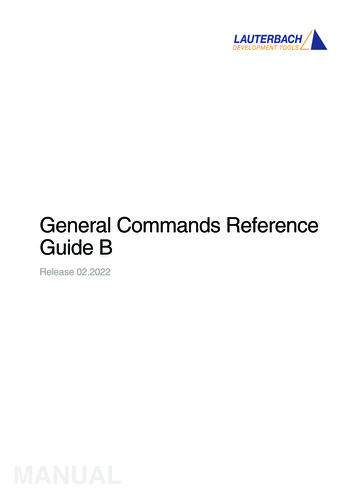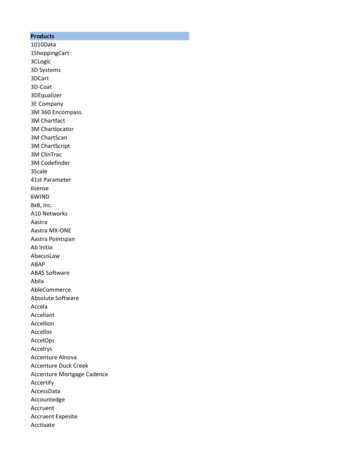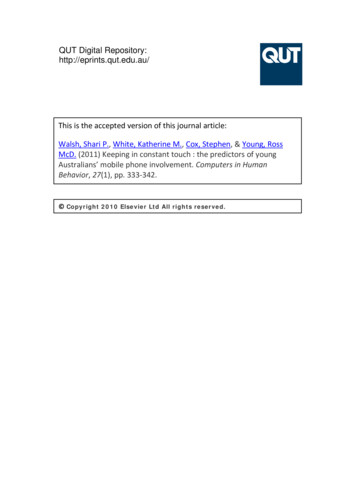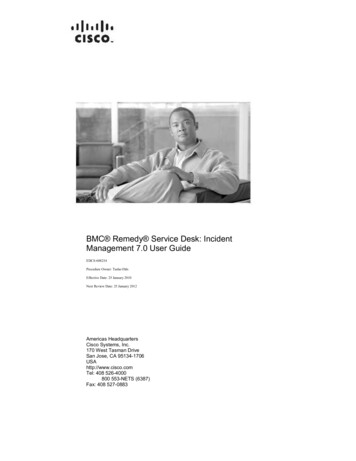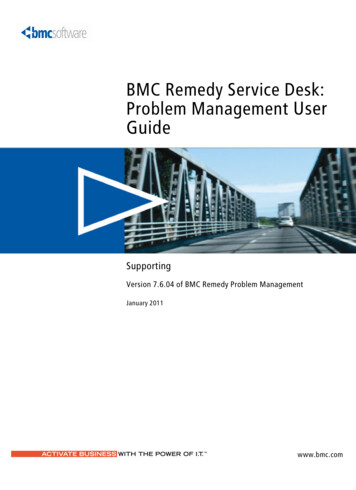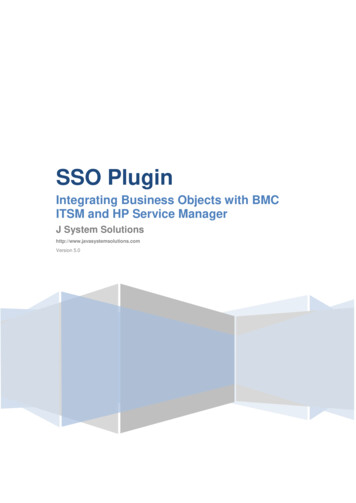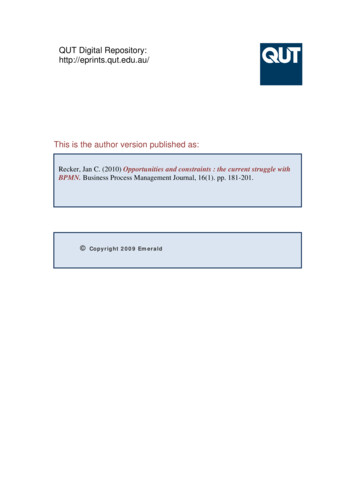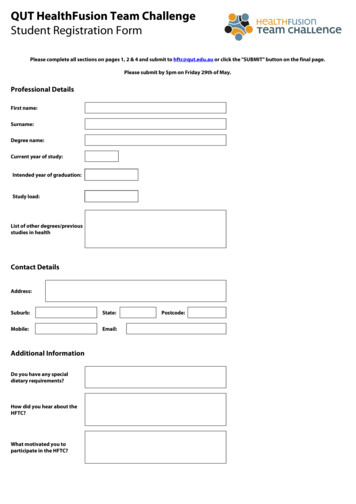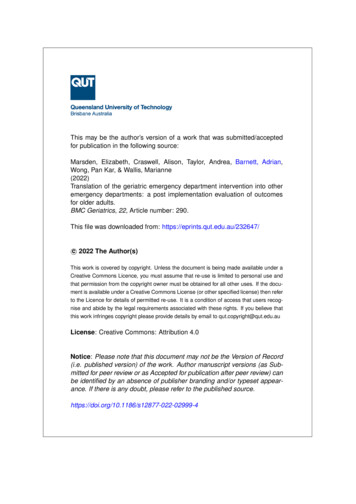
Transcription
This may be the author’s version of a work that was submitted/acceptedfor publication in the following source:Marsden, Elizabeth, Craswell, Alison, Taylor, Andrea, Barnett, Adrian,Wong, Pan Kar, & Wallis, Marianne(2022)Translation of the geriatric emergency department intervention into otheremergency departments: a post implementation evaluation of outcomesfor older adults.BMC Geriatrics, 22, Article number: 290.This file was downloaded from: https://eprints.qut.edu.au/232647/c 2022 The Author(s)This work is covered by copyright. Unless the document is being made available under aCreative Commons Licence, you must assume that re-use is limited to personal use andthat permission from the copyright owner must be obtained for all other uses. If the document is available under a Creative Commons License (or other specified license) then referto the Licence for details of permitted re-use. It is a condition of access that users recognise and abide by the legal requirements associated with these rights. If you believe thatthis work infringes copyright please provide details by email to qut.copyright@qut.edu.auLicense: Creative Commons: Attribution 4.0Notice: Please note that this document may not be the Version of Record(i.e. published version) of the work. Author manuscript versions (as Submitted for peer review or as Accepted for publication after peer review) canbe identified by an absence of publisher branding and/or typeset appearance. If there is any doubt, please refer to the published source.https://doi.org/10.1186/s12877-022-02999-4
(2022) 22:290Marsden et al. BMC -4Open AccessRESEARCHTranslation of the geriatric emergencydepartment intervention into other emergencydepartments: a post implementation evaluationof outcomes for older adultsElizabeth Marsden1, Alison Craswell2*, Andrea Taylor1, Adrian Barnett3, Pan‑Kar Wong4 and Marianne Wallis2,5AbstractBackground: Increasing numbers of older adults with complex health deficits presenting to emergency depart‑ments has prompted the development of innovative models of care. One such model designed to reduce pooroutcomes associated with acute healthcare, is the Geriatric Emergency Department Intervention. This intervention isa nurse-led, physician-championed, Emergency Department intervention that improves the health outcomes for frailolder adults in the emergency department.Methods: This quantitative cohort study aimed to evaluate the healthcare outcomes and costs associated with theimplementation of the Geriatric Emergency Department Intervention (GEDI) for adults aged 70 years and over at twohospital sites that implemented the model using the integrated-Promoting Action on Research Implementation inHealth Services (i-PARHIS) framework. Hospital A was large teaching hospital located in the tropical north of Australia.Hospital B was a medium sized teaching hospital near Brisbane, Queensland Australia.The effect of the intervention was examined in two ways. Outcomes were compared between: 1) all patients inthe pre- and post- implementation periods, and 2) patients seen or not seen by the Geriatric Emergency Depart‑ment Intervention team in the post-implementation period. The outcomes measured were disposition (dischargedhome, admitted); emergency department length of stay; hospital length of stay; all cause in-hospital mortality within28 days; time to re-presentation up to 28 days post-discharge; emergency department and in-hospital costs.Survival analyses were used for the primary and secondary outcome variables and a Cox survival model was used toestimate the associations between variables and outcomes. Multiple regression models were used to examine othersecondary outcomes whilst controlling for a range of confounders.Results: The Geriatric Emergency Department Intervention was successfully translated into two different emergencydepartments. Both demonstrated an increased likelihood of discharge, decreased emergency department length ofstay, decreased hospital costs for those who were admitted, with an associated reduction in risk of mortality, for adultsaged 70 years and over.*Correspondence: acraswel@usc.edu.au2University of the Sunshine Coast, Sunshine Coast Health Institute, 4Doherty Street, Birtinya, QLD, AustraliaFull list of author information is available at the end of the article The Author(s) 2022. Open Access This article is licensed under a Creative Commons Attribution 4.0 International License, whichpermits use, sharing, adaptation, distribution and reproduction in any medium or format, as long as you give appropriate credit to theoriginal author(s) and the source, provide a link to the Creative Commons licence, and indicate if changes were made. The images orother third party material in this article are included in the article’s Creative Commons licence, unless indicated otherwise in a credit lineto the material. If material is not included in the article’s Creative Commons licence and your intended use is not permitted by statutoryregulation or exceeds the permitted use, you will need to obtain permission directly from the copyright holder. To view a copy of thislicence, visit http:// creat iveco mmons. org/ licen ses/ by/4. 0/. The Creative Commons Public Domain Dedication waiver (http:// creat iveco mmons. org/ publi cdoma in/ zero/1. 0/) applies to the data made available in this article, unless otherwise stated in a credit line to the data.
Marsden et al. BMC Geriatrics(2022) 22:290Page 2 of 11Conclusions: The Geriatric Emergency Department Intervention was successfully translated into new sites thatadapted the model design. Improvement in healthcare outcomes for older adults presenting to the emergencydepartment was demonstrated, although this was more subtle than in the original model setting.Keywords: Geriatric, Emergency medical services, Emergency nursing, Knowledge translation, Implementation,Homes for the aged, Delivery of healthcare, Aged careBackgroundHealth systems are experiencing increasing pressurefrom ageing populations as more patients, with multiplecomorbidities, present to emergency departments (ED)with acute illnesses or exacerbations of their underlyingchronic health conditions. Previous research suggeststhat a longer time in the ED is associated with increasesin unnecessary investigations, admission rates, prolonged hospitalisation, and higher in-hospital mortality,for this older cohort [1, 2]. This evidence has stimulatedthe development of a range of models of enhanced carefor older adults in the ED (c.f.3, 4, 5). The evidence fromthese models of care, indicates that a targeted comprehensive geriatric assessment, undertaken with olderadults, results in improved short- and long-term healthoutcomes [6]. One of these models is the Geriatric Emergency Department Intervention (GEDI), which was successfully developed and trialled in a regional QueenslandED and reduced ED length of stay, hospital admission,hospital length of stay and cost, without increasing mortality or same cause re-presentation with increases sustained over time [5, 7, 8].EDs provide a rich and complex landscape in which toundertake innovation research, such as with the GEDImodel [9]. Innovation research studies provide clinicians with new and exciting ways to potentially improvethe efficiency and effectiveness of ED healthcare delivery[10]. However, despite sound evidence, the disseminationof innovations into other EDs is often slow or non-existent [10]. Diffusion and implementation sciences havedeveloped, and these methodologies enable organisational change scholars to assist clinicians in the adoptionand long-term sustainability of evidenced based innovations [11]. Currently there are over 100 reported theoriesspanning several disciplines that are being used by implementation scientists for the planning, evaluation and dissemination of project outcomes [12]. However, the mostcited theories include Diffusion of Innovations [13], integrated-Promoting Action on Research Implementationin Health Services (iPARIHS) [14], Theoretical DomainsFramework [15] and the Consolidated Framework forImplementation Research [16].In this study, the i-PARIHS framework [14] was usedto assist the implementation processes at two sites. Thisframework was chosen as the initial version (PARIHS)was developed after experience working with nursing clinicians to assist them to improve quality of care thoughstandards, introduce audit and quality improvement andchange patient services [17]. This article presents theresults of a study that evaluated the effectiveness of theGEDI model in the two Queensland EDs following structured implementation.MethodsAimsAn implementation science project was undertakenwhich focused on the implementation the GEDI model[5] into other hospital sites. Both quantitative and qualitative data were collected. The overall aim was to evaluate the effectiveness of the implementation of the GEDImodel of care into two EDs. This article presents thequantitative results from the analysis of the effect of theGEDI implementation on healthcare outcomes and costs.Another article reporting the results of the qualitativestudy has been submitted for publication elsewhere.In this quantitative study, the objectives were to compare the health system outcomes of: disposition, ED andHospital length of stay (LoS), ED representation and hospital readmission, all-cause mortality and costs. The analyses focused on comparing patients aged 70 years andolder, who a) presented before and after the introductionof the GEDI model and b) were seen or not seen by GEDIstaff.SettingsTwo Hospital and Health Services EDs in Queenslandwere chosen as the GEDI implementation sites. The senior ED clinicians and managers at these hospitals hadshown early interest in implementing the GEDI model,given the initial trial results, and the supportive fundingfrom the Healthcare Improvement Unit of QueenslandHealth (the state health department) that was availableto support such implementation [5, 18]. Hospital A waslarge teaching hospital located in the tropical north ofAustralia. Hospital B was a medium sized teaching hospital near Brisbane, Queensland Australia.Description of site interventionsThe intervention has been previously described and isoutlined within an Implementation Toolkit and prior
Marsden et al. BMC Geriatrics(2022) 22:290Page 3 of 11publications [5, 18]. Briefly, the GEDI model consists ofadvanced practice nurses, with at least five years experience in geriatrics, who operate an embedded subspecialty team that assists the primary ED nurses andphysicians, focused on the care of older adults aged70 years and older. The GEDI nurses are employed in theED and worked Monday to Friday 07.00 to 17.30 h and07.00 to 15.30 h on weekends. An embedded ED physician champion assists in ensuring acceptance and permanence of the model. During this study, GEDI nursesused the interRAI ED Screener [19] to screen all patientsaged 70 years and older after presentation to the ED toprioritise patients to be seen. This tool provides a rapidmeasure of physical and cognitive dependence as aproxy measure for frailty. The priorities were: all patientspresenting from residential aged care facilities, highfunctioning older adults who might have suffered incapacitating fractures (such as neck of femur), all patientswith interRAI scores of 5–6, those identified as carers fora highly dependent person, and lastly, those with interRAI scores of 3–4. These patients were considered mostat risk of experiencing poor healthcare outcomes, such asre-presentation to the ED, hospital admission and longerED length of stay [20].In the implementation process, however, both sitesmodified the model. This was not discouraged as anintervention should be allowed to adapt to local environments to ensure increased likelihood of success [21].Hospital A’s ED physician champion left approximatelythree months into the implementation and was notreplaced. Some aspects of this role were then undertakenby a supportive geriatrician but this role was not basedin the ED. Hospital A had a specialist gerontology nurseleading the service and internally employed ED nurses,with an interest in older adults, rather than employingspecialist gerontology nurses as GEDI nurses. Hospital Aalso introduced a pharmacist to the GEDI team. HospitalB had a specialist gerontology nurse leading the service,non-ED nurses with gerontology expertise and an emergency physician who operated as a change agent but didnot continue as a champion for the service. In HospitalB, a geriatrician and a physiotherapist were included inthe team. Several GEDI nurses were employed over theimplementation period, none staying in the role for thefull 12 months.site there were two internal facilitators who acted aslocal champions. The GEDI Toolkit [18] was used as aresource, and site visits by internal facilitators to the initial trial site were made. The internal facilitators and thesenior GEDI nurse would have regular telephone andvideoconference meetings. Further details of the plannedimplementation activities and how reality deviated fromthe plans is reported in the qualitative findings from thestudy submitted elsewhere.Approach to ImplementationTable 1 Hospital A and B Pre- and Post-GEDI presentationsThe implementation of the GEDI model used the iPARIHS approach to facilitation [14]. The implementationprocess was managed by two types of facilitators, external and internal. The external facilitators consisted ofthe ED physician and senior GEDI nurse who had beeninvolved in the initial GEDI trial. At each implementationParticipants and data collectionDe-identified data for all patients aged 70 years and older,who presented to the study EDs from Jan 2017 to Dec2018 for Hospital A and from July 2016 to September2018 for Hospital B were retrieved from the electronicmedical databases of the participating hospital and healthservices. Data extraction was undertaken by health service data managers linking ED, inpatient and financialdata. Pre-GEDI is the period prior to the introduction ofthe GEDI model into the departments. For Hospital B,the period between the 30 June and 1 September 2017was not included in the analysis as some GEDI staff, butnot all, were working during this time. Post-GEDI is theperiod after GEDI was fully established in the department. The dates for pre- and post-periods and numbersof presentations are in Table 1.Independent variables that were used to describe thesample and to build multivariable models to compareoutcomes included demographics such as age, sex andIndigenous status, the date and time of presentation andthe clinical diagnosis determined by the reason for presentation as an ICD-10 code, assigned in the ED. The ICD10 code was mapped to 25 major diagnostic categoriesestablished by Clinical Excellence, Queensland Health[22]. Other independent variables included: Intervention group (explained below) arrival by ambulance andthe Australasian Triage Score (ATS) [23] grouped intothree categories (ATS 1&2, ATS 3 and ATS 4&5). The primary outcome variable was disposition (admitted or discharged). Secondary outcome variables were: All causein-hospital mortality; ED LoS (in minutes); Hospital LoS(in days); ED Representation within 28 days for any reason; Readmission within 28 days for any reason; Cost ofED presentation; Cost of hospital admission. Hospitalcosting data were provided by the hospitals’ financialHospitalNumbers of patients aged70 presenting pre-GEDINumbers of patients aged70 presenting post-GEDIHospital A9,3919,349Hospital B8,9339,899GEDI Geriatric Emergency Department Intervention
Marsden et al. BMC Geriatrics(2022) 22:290systems in a system where funding is DRG (diagnosticrelated group) based and variations from DRG are individually costed at patient level post discharge.Statistical methodsA statistician, independent to the study team (AB) provided statistical summaries and analysis. Descriptive statistics were used to describe the patients’ characteristicsin the two time periods.GEDI was examined in two ways: Pre- and post-GEDI periods: comparing all patientsin the post-period with all patients in the preperiod (assessing overall impact of GEDI implementation). Seen by GEDI: comparing patients in the post-GEDIperiod that were either seen or not seen by a GEDIclinician (assessing the impact of the GEDI model).We used survival analysis for the primary outcomegiven the variables were times and subject to censoringfrom competing risks. Cumulative probability curveswere plotted to examine the competing risks of admission and discharge after ED presentation and graphicallyshow any difference due to the intervention. We used acompeting risk survival approach to model the risks ofadmission and discharge, and how these risks dependedon the independent variables. A Cox survival model wasused to estimate the associations between variables andoutcomes. We also used survival analysis for the secondary outcomes involving times, that is re-admission andre-presentation within 28 days, and censored patientswho had not returned at 28 days. Results are presentingusing means and 95% confidence intervals.Multiple regression models were used to examine othersecondary outcomes including all cause in hospital mortality, ED and hospital LoS and costs. In these models thereference categories for independent variables were: Mode of Arrival OtherTriage priority Less urgent/Non-urgentGender FemalePost-GEDI period Pre-GEDIMultiple regression was used to estimate how theGEDI model changed the key outcomes whilst controlling for a range of confounders based on expert knowledge of the system, which were age, gender, ATS, modelof arrival, and major diagnostic group codes of traumaand cardiac. Multiple linear regression was used to examine differences in ED and hospital costs. Multiple logistic regression modelling was used to estimate the riskof in-hospital death. For the logistic model we presentPage 4 of 11the results as prevalence ratios rather than odds ratiosbecause odds ratios are often misinterpreted as prevalence ratios. We also log-transformed (base e) variablesthat had a strong positive skew in the plots and regression models. This was to give a better visual indication ofany difference in the plots, and clearer picture of any differences in the regression models.Checks of the residuals for all models were made tolook for outliers, skew and bimodality. These checks wereadequate and included the cost models – which are oftenpositively skewed. Hospital LoS had a strong positiveskew and so was log-transformed (base e) prior to modelling, and the estimates back-transformed to give theresults on the original scale of days.ResultsA total of 18,740 records for Hospital A and 18,832records for Hospital B were retrieved. The mean age ofpatients (79 years Hospital A and 80 years Hospital B)was similar at both sites during the pre- and post-intervention periods, with approximately half being male.There was a noticeable increase in presentations at Hospital B with total presentations increasing from around160 pre-GEDI to 180 post-GEDI (per week). Therewere no other large differences between the two sites orbetween the two time periods, see Table 2.Hospital A resultsThere was an increased hazard (likelihood) of discharge,(shorter average time to discharge), during the postGEDI period and if seen by a GEDI nurse, see Table 3. Ifa patient was seen by a GEDI nurse or seen during thepost-GEDI period, there were increased numbers offaster discharges, with fewer admissions, visualized inFig. 1. However, there was a significant increase in thetime to admission during the post-GEDI period (Hazardratio 0.88, CI 0.85,0.92) and if seen by a GEDI (Hazardratio 0.76, CI 0.72,0.81). Table 3 highlights that the olderthe patient, the slower the discharge times (Hazard ratio0.93, CI 0.92,0.95). If categorised in the MDC Trauma,there was also a significant increased risk of discharge.Presentations that were a lower ATS priority, such asminor trauma, rather than ATS priority of 1 or 2 (resuscitation or urgent) had an increased risk of admission.The post-GEDI period was associated with a reductionin the chance of re-presentation (Hazard ratio 0.88, CI0.85,0.92).Results (Table 4) suggest that the risk of longer hospital stays (for those admitted) increased in the postGEDI period overall but decreased for those seen by aGEDI nurse. The risk of in-hospital mortality decreasedconsiderably in the post-GEDI period and if seen by a
Marsden et al. BMC Geriatrics(2022) 22:290Page 5 of 11Table 2 Demographic and clinical characteristics of the sample in the two hospitals and two time periodsCharacteristicHospital A PreHospital A PostHospital B PreHospital B PostPresentations—number9391934989339899Age – mean (sd)79 [7]79 (7)80 (7)80 (7)Male sex – n (%)4864 (52)4922 (53)4385 (49)4733 (48)Indigenous – n (%)563 (6)521 (6)123 (1)145 (1)From RACF – n (%)1017 (11)1495 (16)1250 (14)1299 (13)Presenting conditions – n (%)Cardiac1753 (19)1521 (16)1554 (17)2218 (22)Trauma999 (11)895 (10)1578 (18)1646 (17)5762 (61)6453 (69)6928 (78)7527 (76)Arrived by Ambulance – n (%)ATS – n (%)Resus/ Emergent2482 (26)2398 (26)2190 (25)2776 (28)Urgent4614 (49)4755 (51)5166 (58)5469 (55)Less urgent/ Non-urgentSeen by GEDI Team member – n (%)2295 (24)2196 (23)1577 (18)1654 (17)0 (0)3135 (33)0 (0)4151 (42)Legend: SD Standard Deviation, RACF Residential Aged Care Facility, ATS Australasian Triage ScaleTable 3 Survival models for Hospital A and Hospital B time to discharge during the post-GEDI period and if seen by a GEDIHOSPITAL AHOSPITAL BVariableHazard ratioPeriod Post-GEDI1.081.03, 1.131.191.15, 1.24Seen by any GEDI Yes 1.121.06, 1.181.141.09, 1.19Seen by GEDInurse YesN/AN/A1.141.08, 1.20N/AN/A1.141.06, 1.23N/AN/A1.181.10, 1.25Seen by GEDI Geriatri‑cian YesSeen by GEDI physi‑otherapist Yes95% CIHazard ratio95% CIAge ( 5 years)0.930.92, 0.950.960.94, 0.97Sex Male1.000.96, 1.051.010.97, 1.05Triage priority Resus‑ 0.32citation/Emergent0.30, 0.340.470.44, 0.50Triage priority Urgent 0.49Mode ofArrival AmbulanceTrauma YesCardiac Yes0.570.47, 0.520.700.66, 0.730.54, 0.590.650.62, 0.681.571.47, 1.671.421.35, 1.491.091.02, 1.171.111.05, 1.17Note: Hazard ratios above 1 indicate a greater risk (likelihood) of discharge and those below 1 a decreased risk (likelihood)GEDI nurse, however the total number of deaths wassmall (pre-GEDI 44, post-GEDI 18).Overall, for all patients, the mean cost of ED presentation increased with increasing age of the patient( 5 years Age 15, (CI 12, 17;) and by an average ofjust 3 per presentation during the post-GEDI period(CI – 3, 9;) when compared to the pre-GEDI period.However, for patients who were admitted, while the costincreased the older the patient ( 5 years Age 128, (CI 58, 198;)), the cost per admission decreased by an average of 88 per admission (CI – 270, 99;).For patients seen by GEDI in the ED there was asmall mean cost increase of 6 (CI – 2, 14), however,if admitted, there was a large mean cost reduction of 679 per stay (CI – 907, – 441) despite the hospitalLoS being increased (0.63 days, (CI 0.41, 0.87)).
Marsden et al. BMC Geriatrics(2022) 22:290Page 6 of 11Fig. 1 Cumulative probability of admission or discharge in the first 24 h after ED presentation during the pre- and post-GEDI periodTable 4 Secondary outcomes for GEDI modelSecondary OutcomeaHospital LOS (days)Patients seen in post-GEDI period compared to thepre-GEDI periodPatients seen by GEDI compared to thosenot seen by GEDI in the post-GEDI periodHOSPITAL AHOSPITAL AHOSPITAL BHOSPITAL B1.39 (1.21, 1.59)-0.39 (-0.54, -0.23)0.63 (0.41, 0.87)-0.12 (-0.29, 0.05)bRisk of in-hospital death0.41 (0.24, 0.70)0.66 (0.37, 1.16)0.43 (0.15, 0.98)0.84 (0.41, 1.59)cSame cause ED representationNot avail0.96 (0.87,1.07)Not avail1.45 (1.29, 1.64)c0.89 (0.84, 0.95)0.98 (0.92,1.05)1.00 (0.92, 1.09)1.60 (1.49, 1.73)c1.07 (0.90, 1.28)1.10 (0.88, 1.39)1.21 (0.96, 1.53)1.47 (1.14, 1.89)Any cause representationReadmission any reasonNote: Cells show the mean estimates from multiple regression models and 95% confidence intervals in round bracketsadays; b prevalence ratio; c hazard ratioHospital B resultsThere was a higher overall level of discharge and mirrored decrease in admission during the post-GEDIperiod. Admissions also tended to happen sooner in thepost-GEDI period, see Fig. 2. The changes in the probability at four hours may be due to the National Emergency Access Target (NEAT) policy, that was in place atthe time of data collection [24]. The post-GEDI periodwas associated with an increased hazard of time to discharge and admission (Table 3). Therefore, admissionsand discharges occurred faster during the post-GEDIperiod compared to the pre-GEDI period, thus reflecting a decrease in risk of long ED LoS. All three GEDIclinicians (nurse, geriatrician and physiotherapist) andif ‘seen by any GEDI’ variables were associated with anincreased risk of discharge, meaning faster times to discharge, (Table 3). The hazard ratios for time to admissionby the GEDI nurses were well above 1 (1.17, CI 1.11,1.24)indicating a significant increased likelihood of shortertime to admission and shorter ED LoS. This was also seenfor the GEDI Geriatrician (1.12, CI 1.03, 1.22), but thedifference was smaller for the physiotherapist (1.07, CI0.99, 1.15).The post-GEDI period was associated with a shorterlength of hospital stay for all patients admitted (not justthose seen by any GEDI) (–0.39 days, CI –0.54, –0.23)
Marsden et al. BMC Geriatrics(2022) 22:290Page 7 of 11Fig. 2 Cumulative probability of admission or discharge in the first 24 h after ED presentation during the pre- and post-GEDI periodwith no change to representation for same (HR 0.96, CI0.87, 1.97) or any-cause (HR 0.98, CI 0.92, 1.05), or riskof mortality. The risk of all-cause representation wassignificantly higher if seen by any GEDI, (Table 4). Tofurther investigate this, we plotted the representationFig. 3 Monthly re-presentation probability over timeprobability over time, (Fig. 3). The re-presentationtimes are generally consistently different between thetwo groups. However, the proportion of re-presentations drops for the group not seen by GEDI once theGEDI model starts.
Marsden et al. BMC Geriatrics(2022) 22:290To further determine if GEDI consulted on more difficult cases we used a classification tree with a binaryoutcome of seen by GEDI or not (Fig. 4). The tree hastwo splits: age and cost. Patients aged under 78 had a0.31 probability of seeing any GEDI clinician. Whereaspatients over 78 whose total ED cost was over 671 hada 0.57 probability of seeing any GEDI clinician (which is84% more likely).Similar to Hospital A, the overall cost of ED presentation increased with increasing patient age ( 5 years Age 7, CI 5, 9) and by an average of 41 per presentationduring the post-GEDI period (CI 36, 47). However, forpatients who were admitted, while the cost for the olderpatients increased ( 5 years Age 175, CI 71, 281),the cost per admission during the post-GEDI periodsignificantly decreased by an average of 532 per admission (CI – 771, - 278). Patients seen by any GEDI had anincreased cost of 67 per patient (CI 60, 75) comparedto patients not seen by any GEDI. The GEDI doctor wasassociated with an increase cost per admission of 235(CI 38, 452).DiscussionIn this study we aimed to evaluate the effectiveness of thepreviously described GEDI model after its implementation into two different EDs. The results indicate that theGEDI model can be successfully translated. Both sitesshowed that the implementation of the GEDI modelincreased the likelihood of discharge, decreased EDLoS, decreased hospital costs for those admitted, withPage 8 of 11an associated reduction in risk of mortality, for adultsaged 70 years and over. Of note, in Hospital A the costof the admission in the post-GEDI period if seen by aGEDI was less despite having a longer hospital LoS. Thismay be explained by the GEDI team’s input guiding theinpatient team’s decisions around the appropriatenessof costly interventions and investigations. In addition,there was an overall reduction in hospital LoS at Hospital B during the post-GEDI period compared to the preGEDI period regardless of being seen by GEDI or not.Within the Hospital B local government area, there wasa 11% increase in population 70 years in the during thepre- and post-GEDI period [25] likely contributing to theincreased presentations at Hospital B. This may explainthe decrease in hospital LoS in all patients in the postGEDI period due to increased hospital bed pressures atHospital B. Given GEDI staff prioritised older adults whoscreened with increased physical and cognitive dependency and GEDI’s role is to identify more issues earlier, itis not surprising that patients seen by GEDI had a longerhospital LOS, if admitted, compared with those not seenby GEDI at both hospitals. Similarly, the finding that theproportion of re-presentations drops for the group notseen by GEDI once the GEDI model starts implies thatthe GEDI team correctly targeted patients with greatercognitive and physical dependencies.Implementation issues are prevalent in the field of geriatric medicine due to the complexity of care for manyolder adults. Existing interventions require adaptationacross both healthcare disciplines and settings [26].Fig. 4 Classification tree estimating the probability of being seen by any GEDI
Marsden et al. BMC Geriatrics(2022) 22:290Similarly, Dresden et al. [27] observed a difference in outcomes across sites despite implementing the same modelof care. One site observed no difference in admissionrates after assessment by a geriatric care nurse, despite aconsistent, robust implementation framework [27]. Interventions cannot always be implemented with a duplicateprogram model as
ments has prompted the development of innovative models of care. One such model designed to reduce poor outcomes associated with acute healthcare, is the Geriatric Emergency Department Intervention. This intervention is a nurse‑led, physician‑championed, Emergency Department intervention that improves the health outcomes for frail
